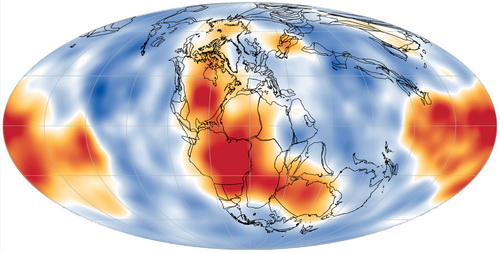We all learned about Pangea in grade school, how the continents now scattered around the globe once fit snuggly together as a supercontinent. But a lot has been discovered about supercontinents since then.
We now know that Pangea wasn't a unique occurrence. There have been at least 3 supercontinents in Earth's past, giving rise to what is now known as "the supercontinent cycle." A paper just published in the brand new journal Nature Reviews Earth & Environment gives the state-of-the art of supercontinent research.
In the inaugural issue of NREE, the editors stated their mission to "encourage Earth scientists to break down disciplinary barriers and collaborate with broader communities in pursuit of alleviating the environmental challenges of the modern world."
This new supercontinent paper does exactly that, bringing together experts from diverse expertise in Earth sciences, from rock hounds to computer modelers. Lead author, Professor Ross Mitchell of the Chinese Academy of Sciences, also stayed true to the mission statement by assembling a team of co-authors that includes both genders, both early-career and senior scientists, and experts from around the world from Finland to Australia.
Said Professor Mitchell, "supercontinent research by its very nature demands international collaboration as knowledge is quite literally required for every continent, through Earths' billions of years of history, and about all layers of the planet."
Beyond demographic diversity, the new paper presents a diversity of ideas on cutting edge science questions. Explains Mitchell, "When reviewing a big topic like supercontinents, it's critical not to pick and choose interpretations that fit your own worldview, but to provide a more balanced view of ideas that are out there."
Taking a Lincoln-like team-of-rivals approach, Mitchell applaud his co-authors for "respecting each others' differences of opinion and working together so effectively." So what is there to disagree about in the world of supercontinent research?
"Just about everything," said Professor Zheng-Xiang Li of Curtin University and co-author. First, geologists argue about the configurations of the ancient supercontinents. "We've made a lot of progress in the past few decades reconstructing two pre-Pangea supercontinents," explains Li. "But we still have a way to go before I would use the word ‘consensus'."
Geologists also debate over the connection between plate tectonics and convection cells in the underlying mantle. Plate tectonic theory explains continental motions at the surface. Mantle convection theory explains the motions of the rocky, but flowing deep mantle. "The trick is linking these two theories, which is what we've tried to do in this paper," said Mitchell.
But there are strikingly contrasting views of how supercontinents and the mantle are exactly linked. There is nonetheless a fascinating clue that there is indeed a link, which gives Mitchell hope. "When we reconstruct supercontinent Pangea and compare it to the structure of the lower mantle," Mitchell explains, "it's like they're made for each other."

Supercontinent Pangea and the structure of mantle at almost 3,000 kilometers deep.
(Courtesy of Ross Mitchell and Bernhard Steinberger.)
Like any good scientific debate, there are two very different interpretations of this correlation. Some on Mitchell's team think that the lower mantle reflects the shape of Pangea because it's the result of the supercontinent forming. Others on the team take the opposite view that the coincidence means that Pangea formed on top of the mantle structure. "We did our best to make it clear that the verdict is still out," says Mitchell.
It appears that this honest approach to scientific debate is appreciated by supercontinent researchers. Professor Timothy Kusky of the Chinese University of Geosciences (Wuhan), who wasn't involved in the study, said of the authors' approach, "There is a nice balance of discussing models, then also discussing the arguments and counterpoints. Very interesting and accurate summary of the current state of knowledge."
The article can be found online: https://doi.org/10.1038/s43017-021-00160-0